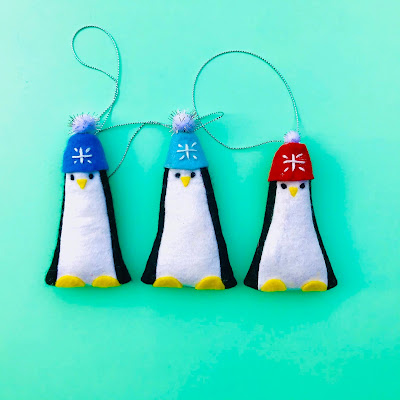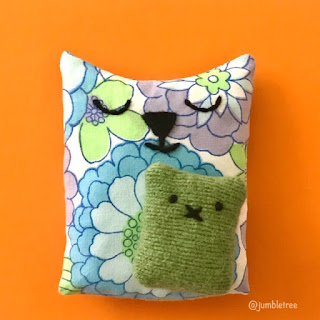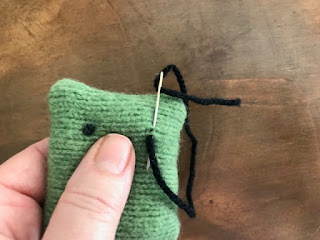I love a tree decoration, we are coming down with them! Every year I'm surprised by the sheer number of baubles and ornaments that come out of the Christmas box, but there's always room for more don't you think??
15.12.20
29.10.20
Halloween egg carton crafts
...poor little thing! Didn't stand a chance..
But Halloween is definitely the time for crafts with a bit more shock value.
And good to have an element of surprise, even if that spells bad news for the fly..
14.10.20
2.7.20
Sleepy Cat with Teddy - #sewasoftie
It's something Trixi is truly passionate about, and each year she organises this worldwide Sew a Softie tutorial hop, with plenty of sewing inspiration from a gang of crafty bloggers EVERY DAY for a month.
I love hand sewing, and can still vividly remember some of the slightly strange things I made when I was little.. like a tiny green felt pony in a matchbox sized bed..
Honestly, I would still describe myself as an enthusiastic, experimental sewer, rather than a particularly accomplished one. But I do believe there's a great sense of joy and reward to be gained from diving in and having a sew, and seeing how much better you can get with a bit of practice. Something I hope I've passed onto my daughter.
Writing a tutorial with a pattern has meant I've had to think the whole process through in way more detail than I've done before, which has been an interesting learning experience!
And this tutorial does sort of fit in with my general crafty 'make do' message, as we've recently moved and I have had to make the most of what I've got here (not much..) So, very few pins! One colour of felt, no interfacing or embroidery thread.
But, if simply using what you can find around the house helps encourage a few more people to have a go, then that's got to be good thing, right?
For Sleepy cat and Teddy, you will need:
PDF pattern here
Fabric 8in.x 15in./20cmx40cm
Felt (for the tail) about 5in.x3in./13cmx8cm
Soft pencil (3b/4b/5b)
About 7in.x4in./18cmx10cm of an old wooly jumper (or piece of fabric/felt) for teddy
Pins
Needle and thread
Black (or brown) embroidery thread
OR yarn (this is what we used) and suitable needle
Button
1. Print out the PDF pattern on a sheet of A4, and cut out the three paper pieces.
Don't forget the hole where the button will go too.
4. Now, use a soft pencil and push it through the holes you've just made, pressing and twisting to make sure you mark the fabric. Remember the hole for placing the button.
OR use some black yarn (like we did), but because it'll probably be quite thick, don't double it up, just thread through and tie a knot at one end.
*KEEP CHECKING THAT YOU HAVEN'T PULLED THE STITCHES TOO TIGHT*
Hold onto the fabric and yarn where the first stitch is, and pull and gently tug the fabric and the rest of the stitches, until they lie flat and even. Make sure you do this before tying off the yarn underneath when you've finished the first eye (there's a quick video tutorial showing you how to finish off here)
Repeat for the other eye.
8. For the nose and mouth, have the paper pattern to hand.
*EASIER OPTION: For the nose, you could cut out a black felt triangle and stick in place with fabric glue.* Otherwise:
Thread the needle and knot the yarn and push the needle through the fabric from underneath, on the pencil line at point A* (have the pattern beside you so you can see the points)
Then back through at B, up through A and back through B. Then up through A* and across and back through A, to complete the triangle shape.
Again, keep checking the fabric hasn't gathered up and you haven't pulled the stitches too tight.
Now it's a case of filling in the triangle by stitching from one side to the other, passing the needle actually through, or as close to the two stitches that form either side of the triangle. Work your way down to the point.
All the time checking you haven't gathered the material by pulling the stitches too tight, and loosening them when you need to.
Again, keep checking the stitches aren't too tight. I know I keep banging on about this, but I promise it's worth the effort!
Tie off your thread underneath.
9. Sew the button on the front where the pencil mark is.
10. For the tail, use a soft pencil to draw around the template on some felt and cut it out. (If you can still see a few pencil marks just turn the tail over)
Pin to the right side of the back piece of the cat. Make sure it's about a cm or half an inch above the bottom edge.
11. Pin the two cat fabric pieces together, so the face and tail are facing inside, and the wrong sides are showing.
To help guide the seam sewing, use the soft pencil to draw a rough pencil line around the fabric shape, about a cm or so from the edge. Use the bottom of the tail as a marker for the line around the bottom of the cat.
12. Start about half way up one side - running stitch is the easiest ( double up your thread and knot the end so the thread doesn't keep slipping out of the needle). You will need to keep checking the stitches aren't too tight or too loose. Go around again if you feel the seam needs to be strengthened.
TIP: Don't make the thread too long, this will mean you'll need to tie off and re-thread as you sew around the shape, but that's less frustrating than tangles and knots..
We used back stitch (here's Trixi's video about how to seam using backstitch), which does take longer, but gives a stronger seam finish.
We used a ladder or slip stitch to close the hole, this is a little harder, but it does give a neat finish as the stitches are almost invisible. But if you prefer use overstitch
It's worth reminding kids to ask before they start chopping up jumpers.. I'm talking from experience here!
15. Fold your piece of jumper in half, pin the pattern to it and cut out. The stretchiness can make this a little tricky, but with such a simple shape it really won't matter if it's not perfect.
Finish 2cm/1in. or so from the start, turn inside out (using something to push out the corners). Add just a little stuffing before sewing the hole closed.
French knots are brilliant for eyes (Trixi has a video tutorial here)
But, if french knots are proving tricky, you could do two small stitches right next to each other for each eye instead. You'll be doing one in and out stitch with the needle, on the teddy front only, which is quite easy to do because it's stretchy. (See below)
18. Then feed the needle back towards the first eye, so it comes out just at the bottom of the eye and towards the middle for the nose/mouth (the X) Use the pattern piece as a guide.
Make a cross stitch here.
On the last stitch of the cross, take the needle through to the back of the teddy, bringing it off to a side and roughly halfway down. Make a knot here by making a little stitch, just through the surface, and thread your needle through the yarn loop before it closes. Don't pull tight until you've checked the face is okay and not stretched too tight.
Make another little stitch in line with the first one, near the other side of the teddy back. Don't tighten it until you're happy the yarn isn't too tight or too loose and, most importantly, will hook over the button on Sleepy Cat. Then, as you're pulling the thread through, pass the needle through the loop to fasten off again.
To get rid of the tail of thread, push the needle back through the teddy right next to the fastening off stitch, and out the side anywhere, pull tight, snip off the thread close to the body, and the tail should be hidden inside.
17.6.20
Sleepy Cat - made from toilet paper rolls!
These sleepy cats are no exception, and they're really not as tricky to make as you might think. It's all about the cutting and the folding. They are made in a similar way to our dog (called Scamp) and pig (called Oink!)
You will need
Toilet paper roll (ours was about 10cm long)
Small piece of spare card (from a cereal box or another TP roll)
Pencil
Ruler
Scissors
Craft glue
Paint
Sponge (optional)
Black pen.
1. Flatten the TP roll with your hand, then press firmly along the creases.
2. Draw two lines across the flattened tube - each one should be about the same distance from the ends, and shorter than the section in the middle (which will be the cat's body)
(For our roll which was roughly 10cm long, we drew lines that were 3cm from each end and the middle part was 4cm. See the picture below).
3. Then lift the tube and line up the two creases, in the middle (see below), and once you're happy, flatten the tube again, pressing along the two new side creases. There should now be four, hopefully evenly spaced crease lines around the tube.
4. While it's still flat, continue the pencil lines across the tube - free-hand is fine, the lines are just there as a guide.
5. Cut down all the creases at both ends to the pencil line. 8 cuts altogether.
6. Fold and press back all the flaps, except for two at opposite ends. These flat pieces will be the bottom part of the cat (the outstretched legs).
7. At one end, cut the top flap off, carefully along the crease. This square-isn piece will be your cats head. Keep it somewhere safe.
8. To define the legs, cut a thin triangle shape in the middle of the flat, unfolded piece of card. Cut right up inside your cat's body. Do this at both ends and round off the paws if you want.
9. Now, at the head end (the one with no top flap), fold one of the side flaps right back against the side of the tube, press firmly along the crease again, then fold this flap in the middle (so, effectively in half) so the top edge of the flap lines up with the bottom part of the flap (the edge of the body), and press firmly along the folds.
10. Do the same on the other side, then push these folded flaps inwards, towards the tube.
11. They should come together well enough, like little doors, to seal off the front of your cat.
They will jut out a bit in the middle (see RHS of photo below), but this is what we want, because this is where the head will be attached later. No need to use any glue at this stage.
12. Do exactly the same to the flaps at the other end, but this time, before you push them inwards, into the tube, cut a slit up the middle of the top flap, right up to the fold (cut a sliver of card out, to make a slightly larger slot - this makes things easier)
As you can see ours isn't exactly in the middle! But it still works, it doesn't need to be perfect. Push this top flap down, to cover the hole, and then press the two side flaps into the slot.
Essentially it's like closing a little box! And it should hold together without glue.
13. Now for the tail - draw on some spare card (we used another tp roll, so both sides were easy to paint)
We made our tail quite curly and quite fiddly to cut out! So do go for a simpler shape if you prefer.
Make the tail extra long at the body end, so you can slot it into the back.
It should stay in position, but take it out again for painting.
14. Take the square of card you cut off earlier for the head, and cut a gentle curve along one side, to form the cat's ears.
15. Time to paint, and we used a sponge, which was fun and really quick! For our marmalade cat we squirted some yellow and a little red poster paint onto a sheet of newspaper (with an extra sheet underneath) and used the sponge to mix the colours and press the paint onto the cardboard pieces. Using the sponge gives a lovely mottled effect.
Sponge both sides of the tail.
(might notice the newspaper's been recycled from the forget-me-not printing project!)
16. When the paint's dry, slot the tail back in (dab some glue on the end, if you feel it's a bit loose) and use a black pen (gel or thin marker pen) to draw on a face, plus claws on the front paws.
We added some tabby stripes to the face on the left with an orange Sharpie. You could draw stripes on the body too if you wanted.
Put a good blob of glue on the back of the head and attach to the top of the protruding flaps at the front. You could glue it so the head is facing forward, or glue the head angled to one side, as we did.
And here's my real sleepy cat!!
Subscribe to:
Posts (Atom)
























































